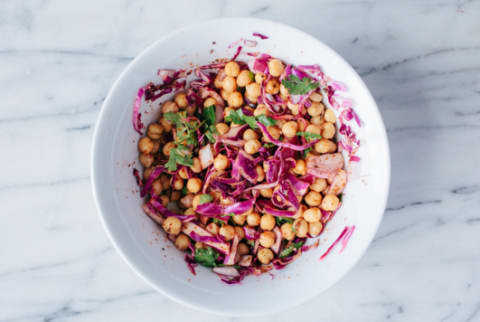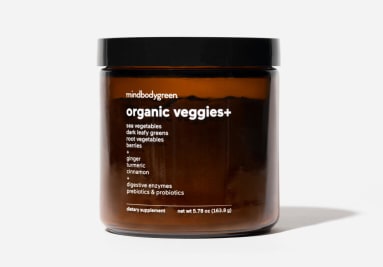Everything You Need To Know About Prebiotics, According To A Doctor


Probiotics have been getting a lot of glory over the past few years for supporting digestive health, and they certainly deserve it. As a medical doctor, I'm a big fan of probiotics to aid the gut because they work to restore friendly flora, while outcompeting1 nasty pathogens like unfavorable bacteria, yeast, and parasites.
However, although they get less attention, prebiotics may also play an important role in gut health.
What are prebiotics?
Prebiotics are essentially compounds that feed on the friendly bacteria in the gut. These probiotic "backups" aren't digested or absorbed in your gastrointestinal (GI) tract; instead, they bypass your small intestine and head straight for your colon, where they promote a healthy gut environment.
Prebiotics fall under several categories2, including fructans (also called fructooligosaccharides or FOS) and resistant starch, according to a research review published in Foods. Each feeds different types of gut flora including the key probiotic strain—Bifidobacterium—that helps with bowel regularity, according to a review of research published in Nutrients. The general rule is that to get labeled a "prebiotic" an ingredient must resist small-intestinal absorption, be fermented by intestinal microflora (probiotics), and stimulate healthy gut flora.
How to supplement with prebiotics.
Studies have shown that inulin, oligofructose, oligosaccharides, lactulose, and resistant starch meet all aspects of the definition of prebiotics3, according to a review of research published in Nutrients. But in supplements, the most common form of prebiotics is generally via fibers, especially chicory root fiber (inulin). These powder supplements can be used to deliver therapeutic amounts of prebiotics. Try adding them to your smoothies or bowl of oatmeal for an extra dose of prebiotic benefits.
Some supplements even combine probiotics with prebiotics, if you're looking for a double dose of benefits. In my own practice, I use prebiotics and probiotics in tandem to aid the gut.
Another convenient way to boost your intake of prebiotics is by supplementing with the aforementioned resistant starch3, such as potato starch, which works even if you're on a low-carb diet or don't do well with nightshade vegetables.
How to add prebiotics to your diet.
While supplements are convenient and the best way to know how many prebiotics you're getting, you can also up your prebiotics count with food. Raw chicory root is your best bet: Prebiotics compose about 65 percent of its total weight. Raw Jerusalem artichoke ranks second, with about 32 percent of total weight as prebiotics. Other prebiotic foods include dandelion greens, whole grain breads, avocado, peas, apple cider vinegar, potato skins, and allium vegetables (like onions, garlic, and scallions).
One way to incorporate prebiotics is through a nutritious salad with raw dandelion greens—about a quarter of its weight is prebiotics, and it also supports liver and kidney detoxification. Bonus points for adding prebiotic-fiber-loaded chickpeas. To optimize gut health, incorporate soluble-fiber foods in the salad like apples, lentils, ground flaxseeds, and nuts, which slow digestion and steady your blood-sugar response.
One of my favorite prebiotic-probiotic combos is coconut water kefir (grab the recipe below), which is both a delicious carbonated beverage and a tonic to balance your gut ecosystem.
Coconut Water Kefir
Makes 4 cups
Ingredients
- 3 tablespoons water kefir grains*
- 4 cups pasteurized coconut water
- 1 cup fresh strawberries or blueberries
- 1⁄2 cup fresh lemon juice (optional)
* Water kefir grains can be found in natural-food stores or online at Amazon. With proper care, the culture can be used indefinitely to create probiotic-rich kefir. Your grains will not grow as quickly in coconut water as they will in a nice bath of nutrient-rich sugar. Refresh and reactivate the kefir grains in sugar water (1⁄4 cup sugar in 4 cups water) for 24 to 48 hours between batches of Coconut Water Kefir. The sugar water will keep the grains healthy for the long term.
Method
- Place the water kefir grains and the coconut water in a jar. Cover the jar loosely with a lid or cheesecloth and allow the kefir grains to culture the coconut water for 24 to 36 (and no longer than 48) hours at room temperature.
- Once the culturing is complete (the mixture will have thickened), remove the kefir grains with a slotted spoon and store in a separate glass container filled with sugar water (as above) to keep the kefir grains alive and active.
- You may drink the Coconut Water Kefir by itself, but for an added twist, puree the cultured coconut water with prebiotic berries and lemon juice in a blender to your desired consistency. The Coconut Water Kefir will last 1 to 3 weeks in the fridge; when blended with the berries and lemon juice, it will last for 2 to 3 days in the fridge. Serve cold.
Potential prebiotic side effects.
Prebiotics are totally safe, and you likely won't experience any side effects with food. But if you use prebiotic supplements, especially powders, introduce them to your diet slowly. We lack the enzymes to break down fructans and other prebiotics, and too many at once can create abdominal bloating, gas, and pain. Just give your body time to acclimate, and you'll be helping promote a healthier gut in no time.

Vincent M. Pedre, M.D., medical director of Pedre Integrative Health and president of Dr. Pedre Wellness, is a board-certified internist in private practice in New York City since 2004. He completed his bachelor’s degree in Biology at Cornell University before attending the University of Miami School of Medicine and completed his residency in Internal Medicine at the Mount Sinai School of Medicine. He has appeared on the Martha Stewart Show and ABC and is the author of Happy Gut: The Cleansing Program to Help You Lose Weight, Gain Energy, and Eliminate Pain. Dr. Pedre is a clinical instructor in medicine at the Mount Sinai School of Medicine and is certified in yoga and medical acupuncture.

